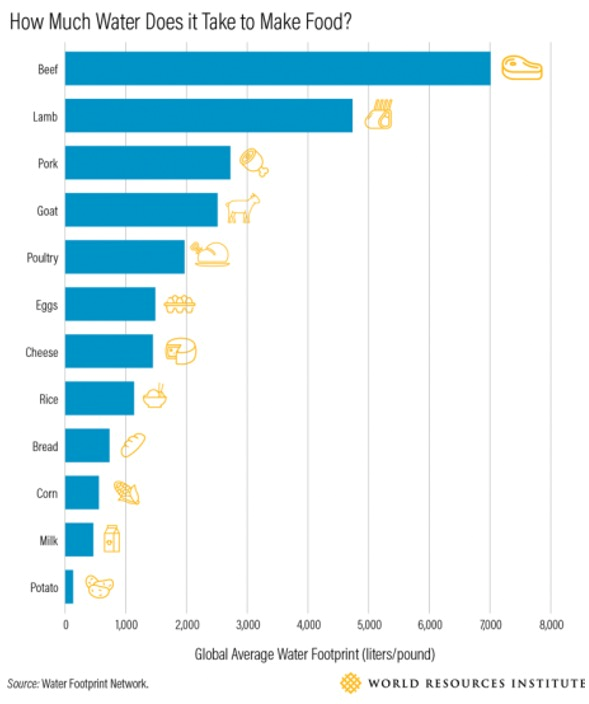
Every day, each of us generally consumes about 100 gallons of water for our basic needs of drinking, bathing, cooking, toiletries, etc. (USGS, 2019; Kobir, 2024; and Philadelphia City Government, 2024). The United States Geological Survey (USGS) estimates that the average American needs 80-100 gallons per day for basic use and consumption (indoor use). The Arizona Department of Water Resources (ADWR) estimates that Arizonans consume an average of 146 gallons of water per day (ADWR, 2024).
As discussed in a recent article in this newsletter (Silvertooth, 2024) the water required to produce the food supporting an average Arizonan can range from 800 to 1,500 gallons per day. Thus, we can use an estimate of 1,000 gallons consumed per day to support our individual food requirements (Anyabwile and Walker, 2019; Wheeler, 2022; Food Print, 2024; Michel, 2023; Smith, 2012).
If this estimate of “virtual water” use is expanded to include clothing, appliances, vehicles, and other items in our common daily use the average water footprint for Americans easily comes up to 2,000 gallons of water per day (ASPE, 2022).
Looking at this more closely, we can see quite a wide range of water requirements to produce some common food items (Figure 1). It is interesting to note the increasing water requirements associated with meat products and that beef is commonly found at the top of the list.

Figure 1. Water requirements to produce some common food
items. Source: World resources institute, Anyabwile and Walker, 2019.
Considering daily indoor use and diet, a person can develop estimates on their own personal daily water consumption and water footprint by use of one of the water footprint calculators available on-line (i.e., Water Footprint Calculator).
Some good examples of water requirements (footprint) for basic food and daily use products include the following (Wade, 2024):
The important point to consider is that we all use more water every day than is commonly realized. Water is essential to support all life and it takes a lot of water to grow plants and support animals that everyone needs to live and survive.
There is a strong demand for the food products shown in Figure 1 and all other food products as well. As consumers, we are all the direct beneficiaries of the water used to produce the crops with all the fruits and vegetables that come from them. Healthy animals require good food, which all comes from plants, i.e., alfalfa. Everything we consume has a significant water footprint.
We commonly devour our way through tons of good food while being totally oblivious to the reality of what it takes to put it all in the markets and ultimately on our kitchen tables. It is good for us to recognize the realities of the water requirements that support the production and provision of our food, particularly in these times of water shortages.
References:
Anyabwile, A. and S. Walker. 2019. 5 Ways to put food on a water diet. World Resources Institute. https://www.wri.org/insights/5-ways-put-food-water-diet
Arizona Department of Water Resources. 2019. Water Your Facts. Arizona Water Facts. https://www.arizonawaterfacts.com/water-your-facts
Arizona Department of Water Resources (ADWR). 2024. Conservation. https://www.azwater.gov/conservation/public-resources
ASPE. 2022. New research shows most Americans are unaware of their daily water consumption. ASPE Pipeline. https://aspe.org/pipeline/new-research-shows-most-americans-are-unaware-of-their-daily-water-consumption/#:~:text=Most%20believe%20they%20use%20less%20than%20100%20gallons,indirectly%20%28e.g.%2C%20the%20water%20required%20to%20produce%20food%29.
Food Print. 2024. The Water Footprint of Food. https://foodprint.org/issues/the-water-footprint-of-food/
Kobir. 2024. How many gallons of fresh water do we use per day. https://medium.com/rocklinca/how-many-gallons-of-freshwater-do-we-use-per-day-7987edf6b1bb
Michel, D. 2023. Water and Food: How, When, and Why Water Imperils Global Food Security. Center for Strategic and International Studies. https://www.csis.org/analysis/water-and-food-how-when-and-why-water-imperils-global-food-security
Philadelphia City Government. 2024. Gallons Used Per Person Per Day. https://water.phila.gov/pool/files/home-water-use-ig5.pdf
Smith, T. 2012. World Water Day: How much water do you use in a day? Climate Home News. https://www.climatechangenews.com/2012/03/22/world-water-day-how-much-water-do-you-use-in-a-day/
United States Geological Survey. 2019. How much water do I use at home each day? https://www.usgs.gov/special-topics/water-science-school/science/water-qa-how-much-water-do-i-use-home-each-day
Wade, M. 2024. Where does our water wind up? Ag Alert, California Farm Bureau Federation. 7 February 2024.
Water Footprint Calculator. 2024. https://watercalculator.org/water-footprint-of-food-guide/
Wheeler, M. 2022. Did You Know’ Series: How Much Water Are We Actually Using? Virginia Water Resources Research Center, Virginia Tech University. https://www.vwrrc.vt.edu/2022/03/31/did-you-know-series-how-much-water-are-we-actually-using/
At events and in the halls of the Yuma Agricultural Center, I’ve been hearing murmurings predicting a wet winter this year…
As the Yuma Sun reported last week, “The storms of Monday, Aug. 25 [2025], were the severest conditions of monsoon season so far this year in Yuma County, bringing record-rainfall, widespread power outages and--in the fields--disruptions in planting schedules.”
While the Climate Prediction Center of the National Weather Service maintains its prediction of below average rainfall this fall and winter as a whole, the NWS is saying this week will bring several chances of scattered storms.
These unusually wet conditions at germination can favor seedling disease development. Please be on the lookout for seedling disease in all crops as we begin the fall planting season. Most often the many fungal and oomycete pathogens that cause seedling disease strike before or soon after seedlings emerge, causing what we call damping-off. These common soilborne diseases can quickly kill germinating seeds and young plants and leave stands looking patchy or empty. Early symptoms include poor germination, water-soaked or severely discolored lesions near the soil line, and sudden seedling collapse followed by desiccation.
It is important to note that oomycete and fungal pathogens typically cannot be controlled by the same fungicidal mode of action. That is why an accurate diagnosis is critical before considering treatments with fungicides. If you suspect you have seedling diseases in your field, please submit samples to the Yuma Plant Health Clinic or schedule a field visit with me.
National Weather Service Climate Prediction Center: https://www.cpc.ncep.noaa.gov/
National Weather Service forecast: https://forecast.weather.govTime flies. February is right around the corner and that means it is farm equipment/ag trade show season. Upcoming regional events include the World Ag Expo, Tulare, CA, February 13-15, the Southwest Ag Summit, Yuma, AZ, February 20-22, and AgroBaja, Mexicali, Mexico, March 7-10. If you are interested in the latest ag tech and farm machinery, all are outstanding events and well worth attending. For more information, click on the links below.

Fig. 1. Upcoming farm equipment/ag trade show events: World Ag Expo, Tulare,
CA, February 13-15, 2024 theSouthwest Ag Summit, Yuma, AZ, February 20-
22,2024 and AgroBaja, Mexicali, Mexico, March 7-10, 2024.
This time of year, John would often highlight Lepidopteran pests in the field and remind us of the importance of rotating insecticide modes of action. With worm pressure present in local crops, it’s a good time to revisit resistance management practices and ensure we’re protecting the effectiveness of these tools for seasons to come. For detailed guidelines, see Insecticide Resistance Management for Beet Armyworm, Cabbage Looper, and Diamondback Moth in Desert Produce Crops .
VegIPM Update Vol. 16, Num. 20
Oct. 1, 2025
Results of pheromone and sticky trap catches below!!
Corn earworm: CEW moth counts declined across all traps from last collection; average for this time of year.
Beet armyworm: BAW moth increased over the last two weeks; below average for this early produce season.
Cabbage looper: Cabbage looper counts increased in the last two collections; below average for mid-late September.
Diamondback moth: a few DBM moths were caught in the traps; consistent with previous years.
Whitefly: Adult movement decreased in most locations over the last two weeks, about average for this time of year.
Thrips: Thrips adult activity increased over the last two collections, typical for late September.
Aphids: Aphid movement absent so far; anticipate activity to pick up when winds begin blowing from N-NW.
Leafminers: Adult activity increased over the last two weeks, about average for this time of year.







